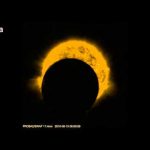As the US enjoyed a total solar eclipse on 21 August 2017, ESA’s Sun-watching Proba-2 satellite captured three partial eclipses from its viewpoint, 800 km above Earth. Proba-2 orbits Earth about 14.5 times per day, and thanks to the constant change in viewing angle, it dipped in and out of the Moon’s shadow several times during the solar eclipse.
The Proba-2 images were taken by the SWAP imager, and show the solar disc in extreme-ultraviolet light to capture its turbulent surface and swirling corona corresponding to temperatures of about a million degrees.
Credits: ESA/Royal Observatory Belgium



